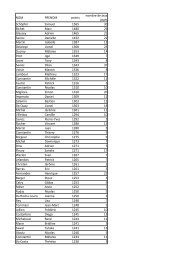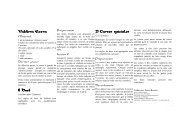Les jeux pour public averti
Les jeux pour public averti
Les jeux pour public averti
- No tags were found...
Create successful ePaper yourself
Turn your PDF publications into a flip-book with our unique Google optimized e-Paper software.
terms of bandwidth usage [5]. When comparing the SNR to the incoherent detection receiver, the SNR for theheterodyne case is 3 dB higher [6], even though it requires a more complex design with the additional electronics foroptical synchronization. Also, the SNR of the homodyne is four times larger than that of the incoherent receiver [2], [6].Strict polarization control of local oscillator in optical source is also a challenge with regard to coherent detection in FSOcommunication. However, the incoherent detection of FSO signals is more common in practice due to the simplicity inhardware design.2.1. FSO Signal through Gaussian ChannelThe detector of an incoherent OOK signal requires a likelihood based threshold value of the received current inorder to make a decision. Assuming no channel fading from the channel mode, the optimal bit error rate is calculated as[5]1 ⎛⎞⎜I1− I0BER = erfc⎟(1)2⎝ 2 ( σ1+ σ0) ⎠and I D is given byσ0I1+ σ1I0I D=(2)σ0+ σ1where I 1 and I 0 are the statistic mean of the generated current at the receiver and σ1and σ0are the standard deviationsfor bits '1' and '0', respectively. Since the various noise currents are not correlated, σ1and σ0can be expressed as thesum of two AWGN additive noises of shot noise and thermal noise [6], [8]. In the case of using a p-i-n photodetector2( qB ) 1/ 2eq I1σ2( qB σ ) 1/ 2σ = +1 2 nσ 0 = 2 eq I 0 + n(3)I1and I0are independent of NEBW and depends just on the transmitted power, background noise and dark currentnoise [8-9]. Also, σnas the standard deviation of the Gaussian noise current due to thermal noise at the photodiodereceiver and has a direct relation to NEBW [8]2σ n ∝ B eq(4)In Fig. 1, we demonstrate the effect of Beqon the FSO receiver performance, using different values of the receivedpower of bit '1', P 1 . Given that optical received power for the bit '0' is zero, P 1 =2P t , where P t is the average transmittedoptical power. Consequently, NEBW in the optical receivers is limited by the available bandwidth of transmitted signal[10]. As a non-return-to-zero (NRZ) transmission format, OOK causes the NEBW by B eq= bitrate 2 . The figure clearlyillustrates performance improvement when increasing transmitted power. Data indicates that a 10% increase in thereceived power is equivalent to a reduction of bit rate by 1 percent in order to maintain identical BER performance. Forexample, it is observed that to maintain a BER value of 10 -9 , when the transmitted power decreases from -35.2 dBm to -45.2dBm, the transmission bit rate must be decreased by a factor of 0.01. As the transmission bit rate increases, theperformance loss is observed to be much more severe. The signal-to-noise ratio, SNR, at the output of an optical receiveris defined as the ratio of the signal power average at the detector,2Is, to the total noise power average2I N1 . Note thatthe SNR value for bit '0' is equal to zero. Hence, the average received SNR of a FSO link in a Gaussian channel is equalto [5]I222 2s ⎛ I1− I ⎞04RPtSNR = = ⎜ ⎟ =22σ1σ(5)I ⎝ +0 ⎠ ( σ1+ σ0)Nwhere R is detector’s responsivity and P t is the average transmitted power. For simplicity we can assume 2P t R=1 inanalyses. Bit error rate is equivalent to1 ⎛ SNR ⎞BER = erfc⎜⎟ = Q(SNR )(6)22⎝ ⎠1- We have just the received current and so to calculate the SNR, we stated the powers in term of photocurrent.Proc. of SPIE Vol. 7587 75870X-2Downloaded from SPIE Digital Library on 30 Jun 2011 to 129.15.14.53. Terms of Use: http://spiedl.org/terms






